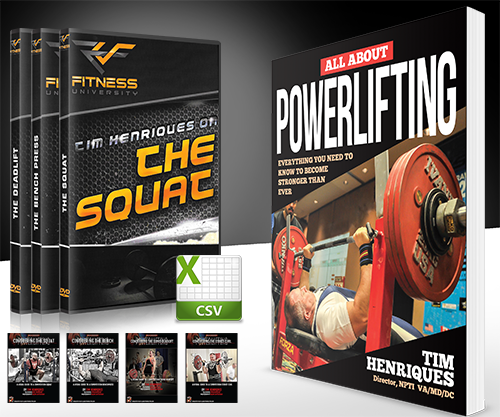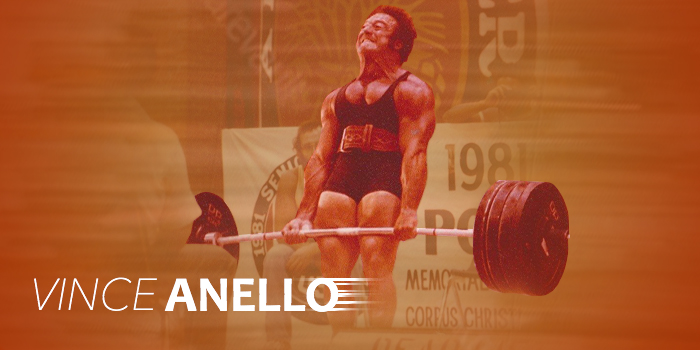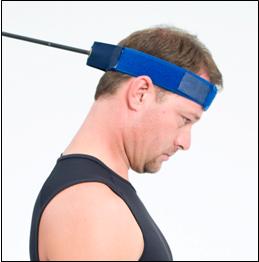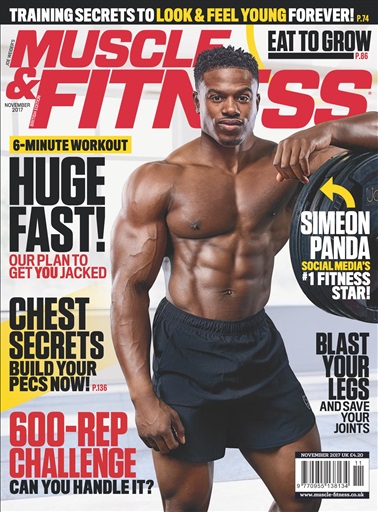Order the Book Package Here:
More From Tim Henriques Here:
71 Articles (so far) Here:
Note: This is a small excerpt from Tim's book "All About Powerlifting" - Highly Recommended!
Interview With Vince Anello (2014)
Vince Anello is a World Champion Powerlifter with an incredible 4x bodyweight deadlift; he is the first man in history to deadlift more than 800 lbs at under 200. He held the IPF world record for the deadlift in the 198 lb class for many years. This interview was conducted via email; I sent him these questions and these are his responses to them.
Tim Henriques: Please give us a brief history of yourself.
Vince Anello: I am 63 years old as of this interview. I was born in Cleveland, Ohio. I own and operate Anello Body Fitness, where I train private clients and work out myself. My web site is:
and this page will tell you more about me:
TH: What are your best lifts?
VA: In a competition I have squatted 750, benched 500, and deadlifted 821 officially; I pulled 880 in training, all at 198 lbs.
TH: List some of he titles and awards that you have won.
VA: 20 World Records | 10 National Titles | 5 World Titles | 1998 Induction Strength Hall of Fame York PA.
Click to Enlarge and Read
TH: When did you start training; when did you first compete; what were your first competition lifts?
VA: I started in elementary school. I used to go in the woods and lift rocks and bricks. My first competition I benched 18, squatted 250, and pulled 310, I believe.
TH: How much weight did you lift the first few times you tried the deadlift?
VA: When I first started lifting, I thought 185 was a lot to Deadlift.
TH: Did you experience any plateaus?
VA: Through career my deadlift plateaued at 400, then I reached 500. Then I was elated to get 600, set my goal at 700 and I made that, and then I wanted 800. It took me a couple of years and in 1975 I became the first man under 200 pounds to pull more than 800. Below are videos of my lifts:
810 in 1977 -
http://www.youtube.com/watch?v=rQD9mHTLFCA
1977 World Powerlifting Championships -
http://www.youtube.com/watch?v=hEU1Hyv4rX8
TH: Provide a quick history of the progress you have made in the deadlift since you started.
VA: I pulled 310 in 1966 to a meet best 821 in 1983. In 1976 I pulled in training.
TH: What do you feel is the key to succeeding in the deadlift?
VA: There are hundreds of routines out there and champions have been produced by opposing theories; the common denominator is THE MIND! A Bulldog Mindset. Bite onto a goal and Don't Let Go Until It Is Realized!
Vince Anello Locks One Out
TH: What do you feel is the best way to train for the deadlift for a normal powerlifter?
VA: In the deadlift I would train once a week. The stronger you get, the more rest is needed. Most overtrain. I would cycle my lifts.
TH: What do you think of training with a high frequency (3+ times per week) on the deadlift?
VA: I found one day per week on each powerlift suited me. Sometimes I would deadlift every 10 days. I am not a believer in high frequency deadlift training.
TH: What do you think of training with a medium frequency (2 times per week) on the deadlift?
VA: When I was really at a peak I would just go once per week on each lift; however, I do think you can do light assistance work on the muscle group a second time per week.
TH: What do you think of training with a low frequency (1 time per week or less) on the deadlift?
VA: This is what I believe to be the ideal; as you get stronger you have to get more rest to allow recovery.
TH: what are your favorite assistance exercises for the powerlifts?
VA: For bench press I like flyes and dips, also shoulders and triceps, even hammer curls for stabilizing muscles. I like leg extensions, leg curls, and hack squats; and for the deadlift a lot of grip work.
I also like the negative accentuated deadlift - start with the bar up at the lockout in the rack, move backward, and lower it under control. You can combine this with a deficit deadlift and lower the bar to your ankles. I have pulled 750 in this fashion.
TH: What are your thoughts on squatting and deadlifting on the same day?
VA: You have to squat and deadlift on the same day in the contest. If you squat one day and deadlift the next you won't have the endurance to do both in the contest.
TH: What are your thoughts on training to failure on the competition lifts?
VA: I have trained to failure in bodybuilding but not in powerlifting.
TH: What injuries have you faced and how did you overcome them?
VA: I have had knee injuries, and back injuries. Light rehab work and rest is the best way to overcome the injuries.
TH: How important do you feel that nutrition is to powerlifting performance?
VA: I eat 7 times a day, small meals, and I try to get at least 30 grams of protein at each meal. Carbs I watched when trying to make weight for weight class as I believe a gram of carb holds 2 or 3 ounces of water (this may not be exact but I used this as an estimate).
TH: What do you usually do with your weight and nutrition to prepare for a powerlifting competition?
VA: I would drop carbs and sweat to make weight.
TH: How important do you feel that supplementation is to powerlifting performance: What kind of supplement program do you currently follow? Are you sponsored by any supplement companies and if so, what are they?
VA: I take protein supplements and vitamins. One supplement I believe in now is MonaVie. Two years ago I was demonstrating plyometrics to my athlete clients and I injured my knee. It bothered me for three months. I went to the doctor and they gave me drugs that I took for a couple of days, but I quit those because it made me feel terrible mentally. A client suggested MonaVie; after a week my knee felt better; a month later, no pain. I have not had any pain in 2 years. I know it has Glucosamine Chondroiton in it, but I have taken various forms before, and nothing seemed to help like MonaVie.
TH: What are your thoughts on powerlifting equipment (gear) in powerlifting?
VA: Gear should be used to prevent injury. When I competed it was just starting to become popular. I can't give a fair evaluation of today's equipment because I have not experienced it.
TH: What are your thoughts on steroids in powerlifting. Do you compete in drug-tested competitions?
How do you feel about the effectiveness of drug tests for catching those who use steroids?
How do you feel about the effectiveness of drug tests for catching those who use steroids?
VA: If you lift in a federation that bans drugs or is a drug-free federation, then you should not use drugs.
TH: How would you feel about powerlifting being united? Would you compete in powerlifting if it was united and raw? Would you compete in powerlifting if it was united and single ply? Would you compete in powerlifting if it was united and multi-ply? What do you think the key to unification is?
VA: I would like to see powerlifting united but there are so many different opinions and paths today that it would be extremely hard. I am retired now, and it is hard to speculate which path I would follow in my prime. I have lifted in an era that at its start did not allow even knee wraps to the full gear we have available now.
TH: What is your thought about the importance of having a workout partner(s) of teammates in helping you train for powerlifting?
VA: You need training partners in powerlifting for safety and motivation.
TH: What is your thought about keeping a training journal while powerlifting?
VA: I kept a strict journal on all my training. Unfortunately I lost a journal in 1976 which documented my training that I used when I pulled 880 in training. I remember reading it in 1996, but since then I have moved and must have lost or misplaced it.
TH: What books, websites, or coaches do you suggest or follow in your lifting, and what would you suggest other lifters do to learn more about lifting?
VA: Read and absorb as much as you can and find what works for you personally. You must follow your own path, not someone else's: "Be open to everything and attached to nothing." As we go through life we should be constantly experimenting!
TH: What do you attribute your personal success in powerlifting to?
VA: A BULLDOG MINDSET!!! GRASP ONTO A GOAL AND DON'T LET GO UNTIL IT IS ACCOMPLISHED!!!
TH: What advice would you give to someone who was just beginning to take up powerlifting?
VA: Go to contests and observe. Read as much as you can on training and the sport. Seek out an experienced coach.
TH: What advice would you give to an intermediate-level powerlifter to improve his total?
VA: Train the mind as much as the body!
TH: What advice would you give to an advanced-level powerlifter to improve his total?
VA: The mind now is THE MAIN FACTOR IN SUCCESS.
TH: Are there any changes that you would ma powerlifting if you had the power to do so?
VA: I can't and would not want to. I would like to see powerlifting more popular with the public. I think a top champion powerlifter is just as much as great athlete as a champion baseball player! But the latter makes millions!!! LOL.
TH: Do you have anything else that you would like to say to powerlifters and people interested in powerlifting?
VA: WE ARE ALL BROTHERS AND SISTERS IN THE STRONGEST SPORT IN THE WORLD REGARDLESS OF FEDERATION! GOD BLESS YOU!!!
VA: WE ARE ALL BROTHERS AND SISTERS IN THE STRONGEST SPORT IN THE WORLD REGARDLESS OF FEDERATION! GOD BLESS YOU!!!




















